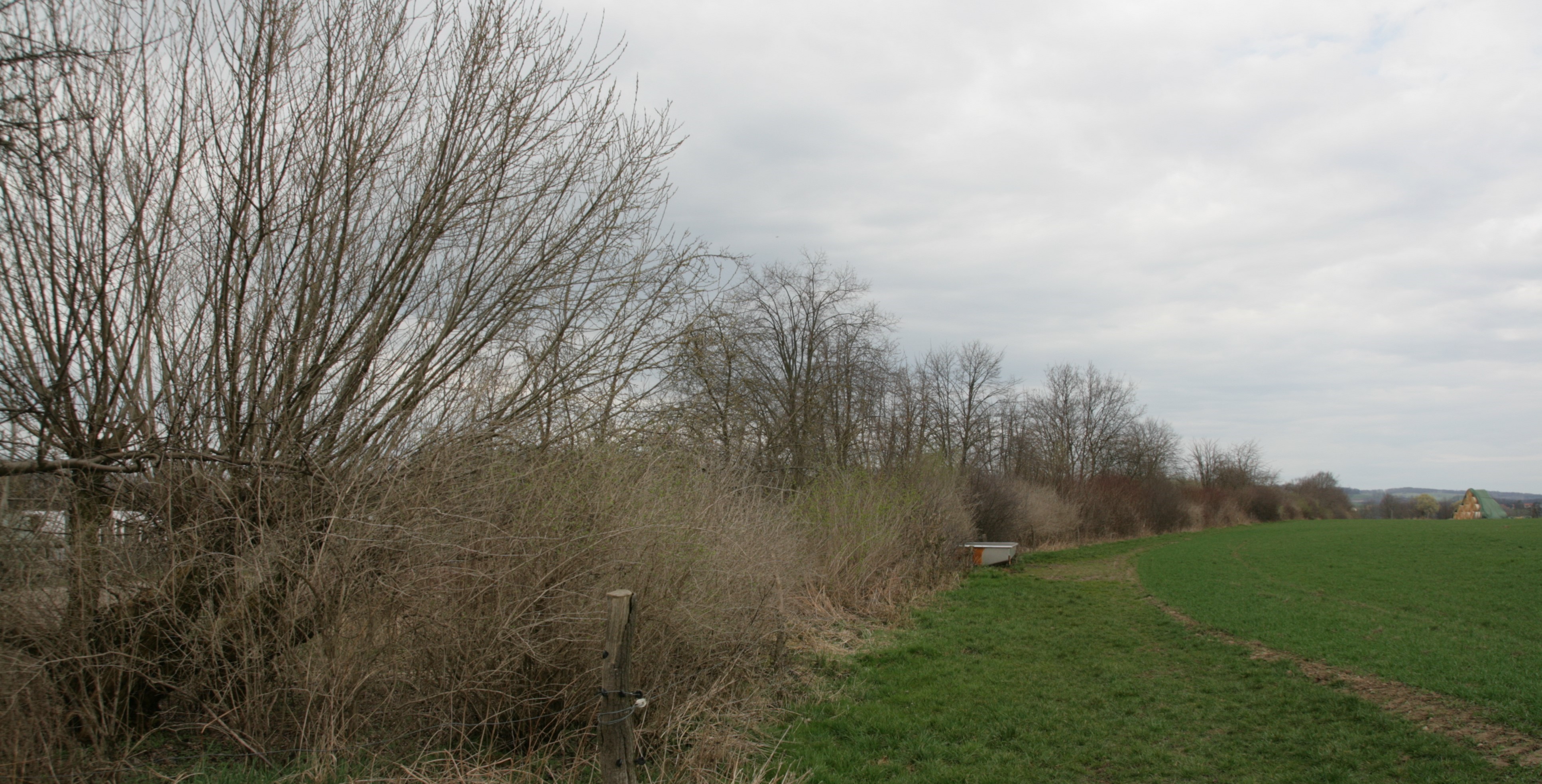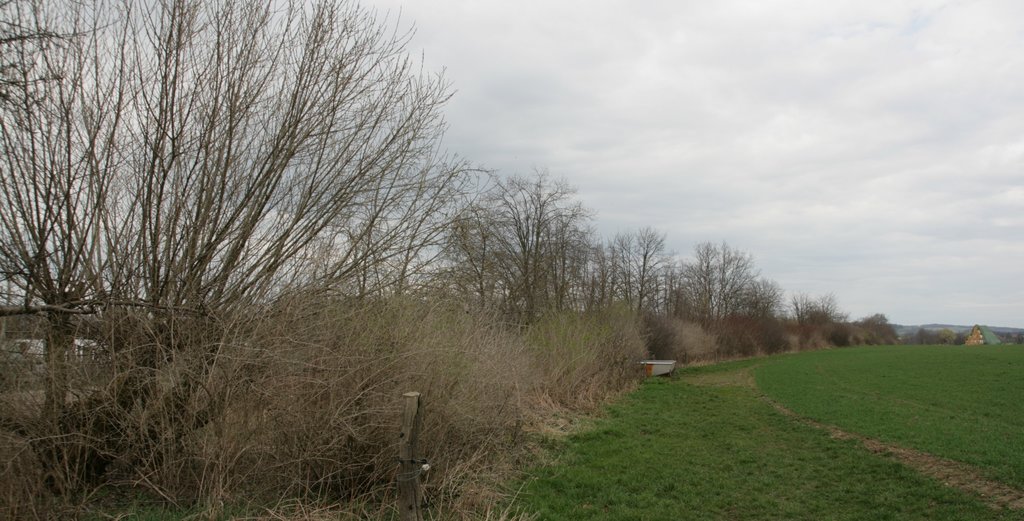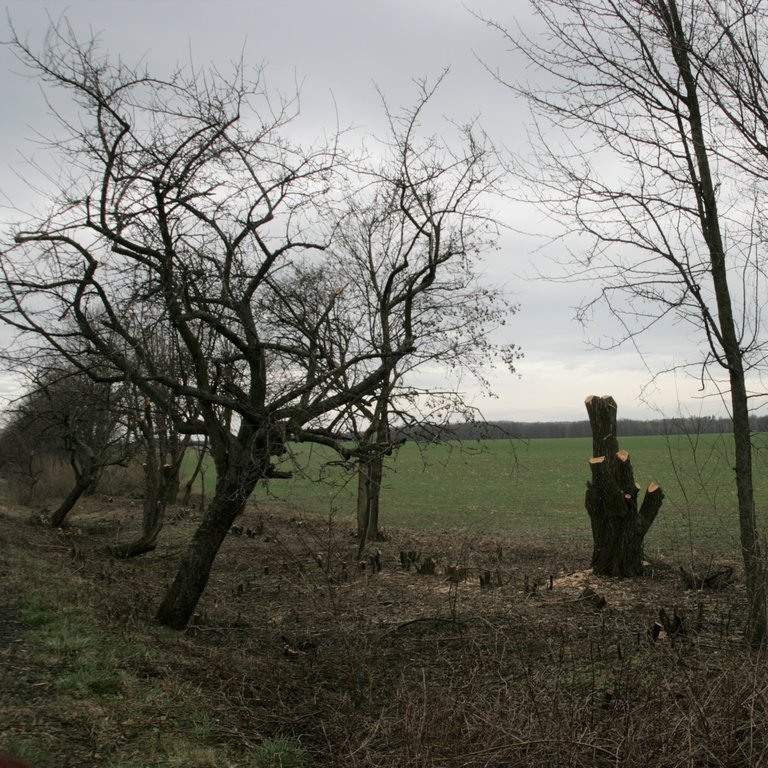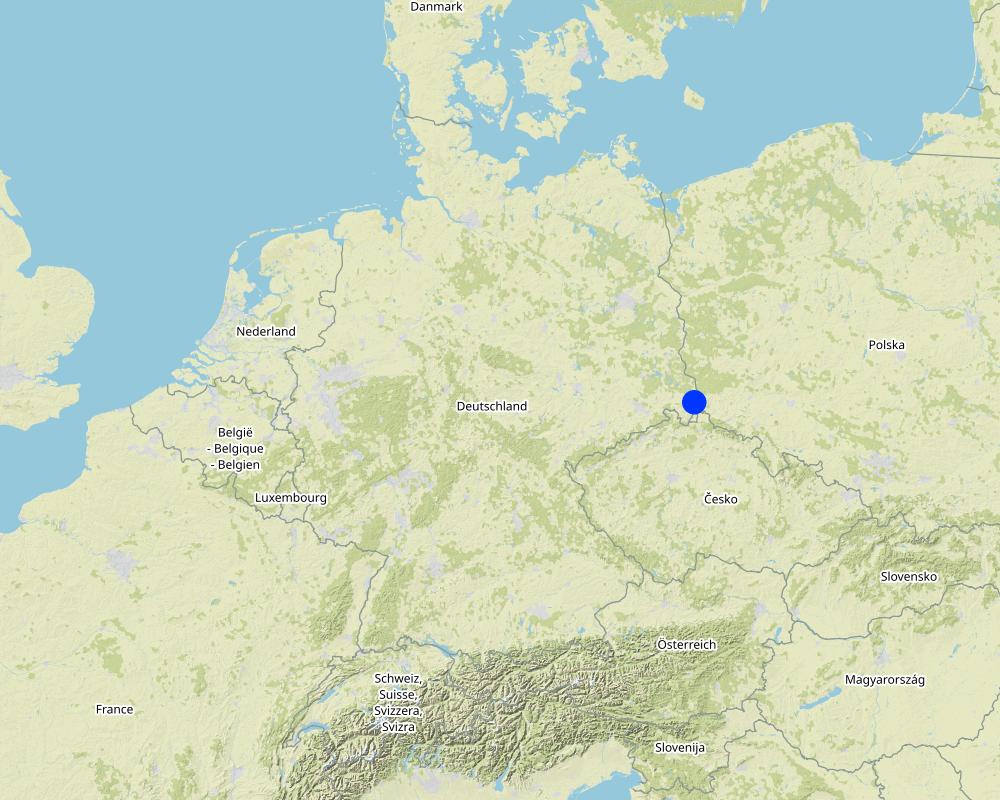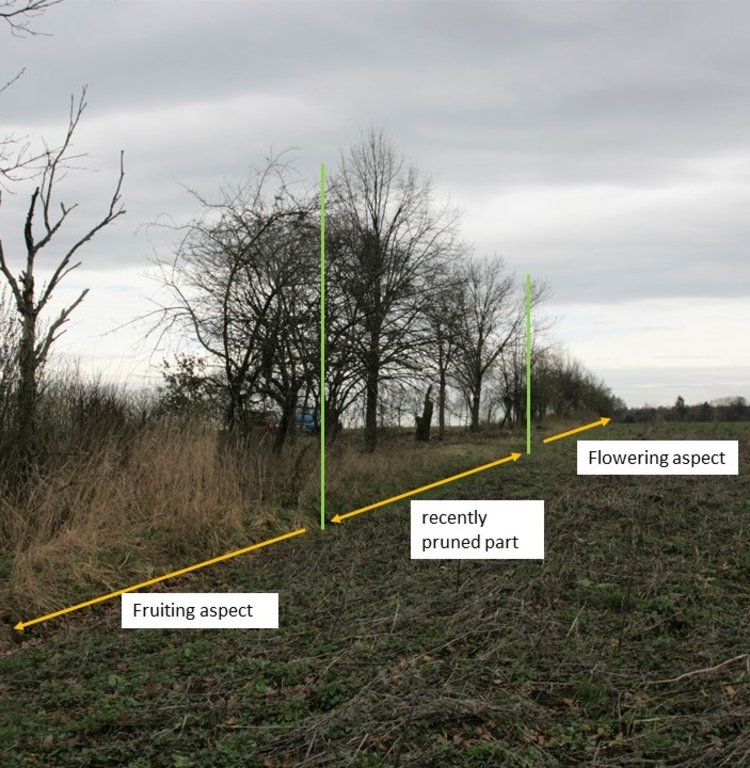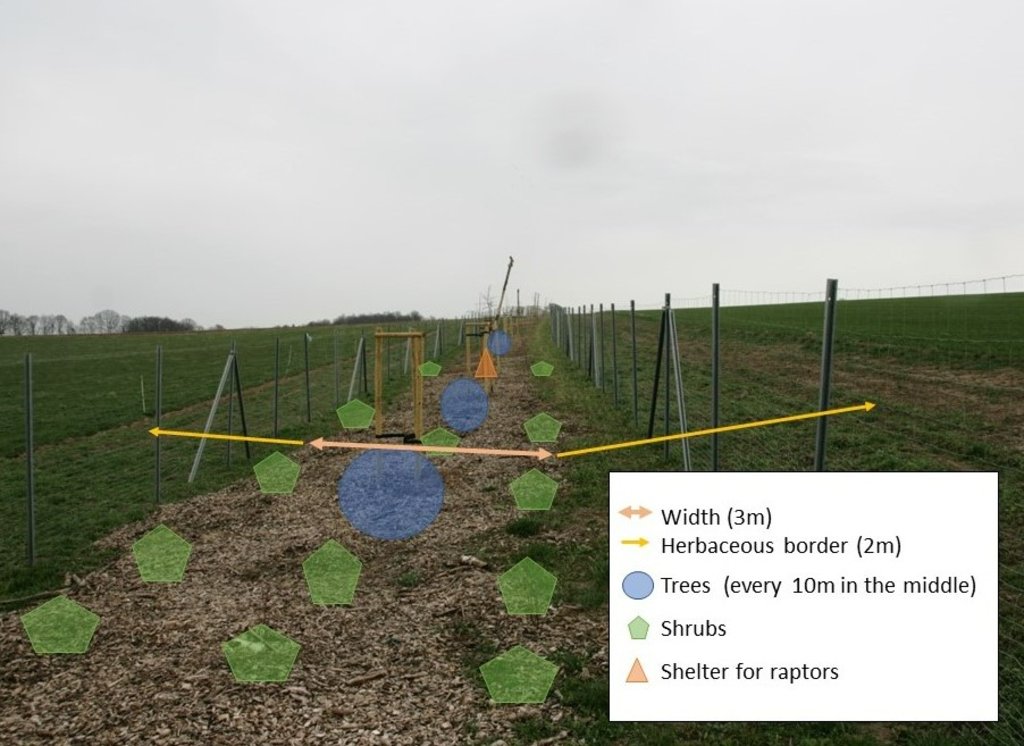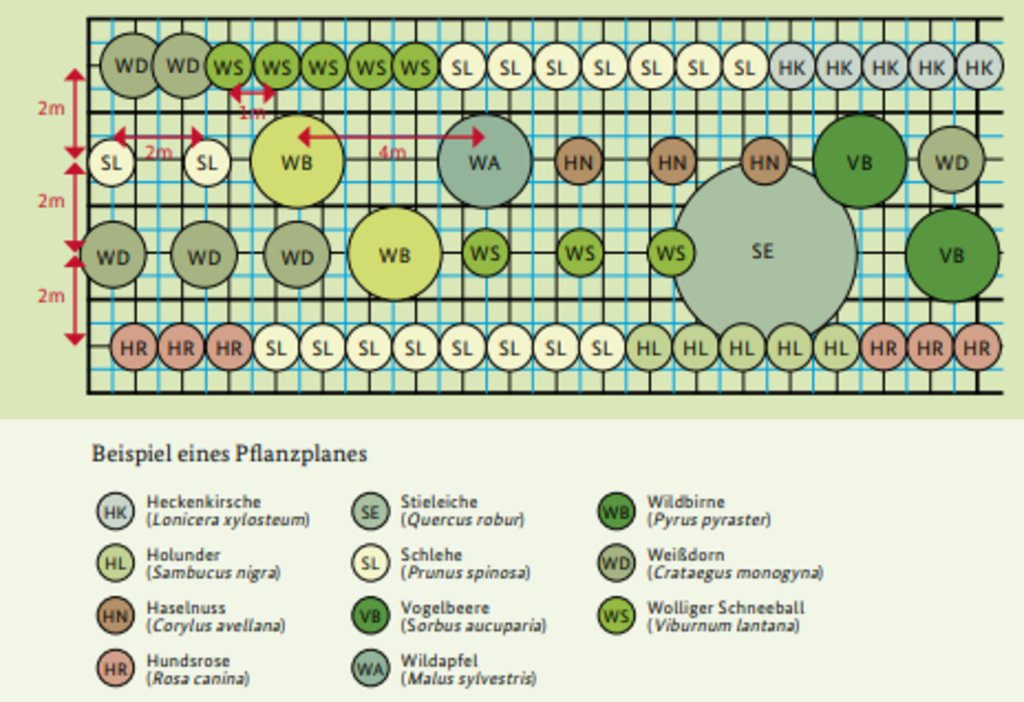Hedges to subdivide fields and provide environmental benefits [德国]
- 创建:
- 更新:
- 编制者: Felix Witing
- 编辑者: Michael Strauch, Mona Pauer
- 审查者: William Critchley, Rima Mekdaschi Studer
Hecken und Baumreihen zur Unterteilung von Feldern
technologies_6266 - 德国
查看章节
全部展开 全部收起1. 一般信息
1.2 参与该技术评估和文件编制的资源人员和机构的联系方式
SLM专业人员:
SLM专业人员:
有助于对技术进行记录/评估的项目名称(如相关)
OPtimal strategies to retAIN and re-use water and nutrients in small agricultural catchments across different soil-climatic regions in Europe (OPTAIN)有助于对技术进行记录/评估的机构名称(如相关)
Helmholtz Centre for Environmental Research (UFZ) - 德国1.3 关于使用通过WOCAT记录的数据的条件
编制者和关键资源人员接受有关使用通过WOCAT记录数据的条件。:
是
1.4 所述技术的可持续性声明
这里所描述的技术在土地退化方面是否存在问题,导致无法被认为是一种可持续的土地管理技术?:
否
2. SLM技术的说明
2.1 技术简介
技术定义:
Hedges are structured shrub communities that subdivide fields, reduce soil erosion, and provide valuable semi-natural habitats.
2.2 技术的详细说明
说明:
Hedges subdivide large fields and provide multiple other benefits. Improved soil structure, and deep and dense root systems in the hedgerow area result in slowing runoff from adjacent land, increasing infiltration rates and capturing sediment. These factors reduce water erosion and nutrient leaching. On steep slopes or embankments, deep roots can prevent wet soils from slipping. Additionally, hedges can acts as windbreaks and thus reduce wind erosion of light soils: simultaneously soil particles in the air are filtered out by hedges. Hedgerows provide a habitat for various wild animals for their food, reproduction, shelter and retreat. The hedge can act as a measure for natural pest control: for example as a habitat for raptors that control voles. A well-placed hedge may improve the microclimate of a field by reducing wind speed and increasing soil moisture in the wind-protected area.
An effective hedge must be strategically sited and carefully established. The optimal hedge is a multi-row hedgerow (at least three rows) with a herbaceous border on both sides. The width of the hedge should be, ideally, 5-6 m (LfULG, 2014). Hedges are best planted parallel to the contour line, along the direction of cultivation, not on the headland, and should be sited a minimum of 20 m from the nearest road. Preparing a planting plan is very important for the establishment of a hedge. It should be based on native species (Kühne et al., 2018). Planting is usually done from October to November. Since a newly planted hedge requires regular costly watering (100 litres for trees, 20 litres for shrubs) spring planting is not advisable.
Maintenance pruning can be divided into hard pruning (every 10-15 years) and pruning for shape and maintenance (every year). Hedges that are not maintained will lack fruit, develop deadwood, or simply die back. Maintenance pruning should be done in February or March when there is no frost and before the plants sprout. A clean, smooth cut is important to prevent fungi or diseases from entering the plants. Hard pruning of hedges means cutting shrubs to a height of a few centimetres. As a general rule, a hedge should be divided into at least three sections, which should be hard pruned in succession. In this way, the hedge always retains a flowering and a fruiting element. Individual trees should be left as shelter/seed trees. The annual maintenance cuts should be used to shape the hedge, but also to remove broken or diseased branches (NABU Niedersachsen).
Hedgerows also have drawbacks for farmers and landowners. They take up cropland, which initially reduces yields. Once established, they cannot be easily removed, limiting management flexibility. It is uncertain whether hedges will be eligible for financial support or whether they will remain eligible after several years. For example, a hedge in Germany that is initially eligible for financial support must prove, after 10 years, that all the required species are still part of the hedge. If not, the money received from the subsidy must be repaid. Moreover, maintenance requires a lot of work, which needs to be compensated by subsidies (Thünen, 2021).
2.3 技术照片
2.5 已应用该技术的、本评估所涵盖的国家/地区/地点
国家:
德国
区域/州/省:
Saxony
有关地点的进一步说明:
Pfaffendorf
具体说明该技术的分布:
- 适用于特定场所/集中在较小区域
技术现场是否位于永久保护区?:
否
Map
×2.6 实施日期
注明实施年份:
2003
2.7 技术介绍
详细说明该技术是如何引入的:
- 通过土地使用者的创新
注释(项目类型等):
It was the land users’ own decision to implement that hedge. They are doing organic farming and wanted some natural shelter against the pesticide drift from the neighbouring – conventionally managed - fields (this was the main reason, beside other environmental benefits of hedges the land users were aware of).
3. SLM技术的分类
3.1 该技术的主要目的
- 改良生产
- 减少、预防、恢复土地退化
- 保护生态系统
- 保持/提高生物多样性
- 适应气候变化/极端天气及其影响
3.2 应用该技术的当前土地利用类型
同一土地单元内混合使用的土地::
是
具体说明混合土地使用(作物/放牧/树木):
- 农林业

农田
- 一年一作
年作 - 具体指明作物:
- 蔬菜 - 根茎类蔬菜(胡萝卜、洋葱、甜菜等)
每年的生长季节数:
- 1
采用间作制度了吗?:
否
采用轮作制度了吗?:
是
如果是,请具体说明:
we have no information about this

森林/林地
- Hedge/ tree row on the field
- rosa villosa (Apfelrose), salix caprea (Salweide)
以上的树木是落叶树还是常绿树?:
- 落叶植物
产品和服务:
- 水果和坚果
- 自然保持/保护
3.3 由于技术的实施,土地使用是否发生了变化?
由于技术的实施,土地使用是否发生了变化?:
- 否(继续问题3.4)
3.4 供水
该技术所应用土地的供水:
- 雨养
注释:
Newly planted hedges require regular watering (100 litres for trees, 20 litres for shrubs).
3.5 该技术所属的SLM组
- 防风林/防护林带
- 横坡措施
- 病虫害综合管理(包括有机农业)
3.6 包含该技术的可持续土地管理措施

植物措施
- V1:乔木和灌木覆盖层
3.7 该技术强调的主要土地退化类型

土壤水蚀
- Wt:表土流失/地表侵蚀
- Wo:场外劣化效应

土壤风蚀
- Et:表土流失
- Ed:风蚀风积

化学性土壤退化
- Cp:土壤污染

物理性土壤退化
- Pc:压实
- Pk:熟化和结壳
- Pi:覆土

生物性退化
- Bc:植被覆盖的减少
- Bh:栖息地丧失
- Bq:数量/生物量减少
- Bs:质量和物种组成/多样性的下降
- Bl:土壤寿命损失
- Bp:害虫/疾病增加,捕食者减少

水质恶化
- Hs:地表水良变化
- Hp:地表水水质下降
注释:
Physical soil degradation refers to the area below the hedge and next to the hedge (3-4 m), but not around it, e.g. in the field. Other types of degradation do refer to the area around the hedge.
3.8 防止、减少或恢复土地退化
具体数量名该技术与土地退化有关的目标:
- 防止土地退化
- 减少土地退化
4. 技术规范、实施活动、投入和成本
4.1 该技术的技术图纸
技术规范(与技术图纸相关):
From a conservation point of view, a well-maintained hedge should always have a flowering aspect (the right part of the hedge in the picture) and a fruiting aspect (the left part of the hedge). After pruning, there is neither a flowering aspect nor a fruiting aspect, so the hedge is divided into at least three maintenance sections with different times for pruning.
作者:
Mona Pauer
日期:
23/03/2023
技术规范(与技术图纸相关):
A hedge should have at least three rows of taller woody plants (trees) every 10 m in the center to low woody plants (shrubs) at the edges. A herbaceous border on both sides is ideal. The width of the strip should be between 5 and 9 meters. An important guide before planting is a planting plan (an example is given in the online version of this documentation).
作者:
Mona Pauer (based on a example of a planting plan in Kühne et al. 2018, p.73)
日期:
23/03/2023
4.2 有关投入和成本计算的一般信息
具体说明成本和投入是如何计算的:
- 每个技术区域
注明尺寸和面积单位:
1 m²
其它/国家货币(具体说明):
€
如相关,注明美元与当地货币的汇率(例如1美元=79.9巴西雷亚尔):1美元=:
0.91
注明雇用劳工的每日平均工资成本:
18.70€ per hour
4.3 技术建立活动
| 活动 | 时间(季度) | |
|---|---|---|
| 1. | Planning / preparing a planting plan | anytime but before planting |
| 2. | Preparing area (preparation of the soil, e.g. ploughing) | late summer- atumn |
| 3. | Planting | late summer- autumn |
| 4. | Protection measures for newly planted hedge (application of a protective coating, construction of protective fence) | after planting |
| 5. | Maintenance measures for newly planted hedge | especially the first year after planting |
| 6. | Optional: preparing area of herbarcious border (preparation of soil) | late summer- atumn |
| 7. | Optional: sawing of herbacious border | late summer- atumn |
| 8. | Optional: rolling of herbacious border | late summer- atumn |
4.4 技术建立所需要的费用和投入
如果您无法分解上表中的成本,请估算建立该技术所需要的总成本。:
25.0
如果土地使用者负担的费用少于100%,请注明由谁负担其余费用:
7.54 €/m² are covered by the state of Saxony, RL Ne/ 2014- Planting hedges, copses and riparian woods (SMUL Sachsen a)
注释:
The implementation costs of a hedge include the plants (trees, shrubs, grass seed) and required materials (e.g. fencing, perches for birds of prey, anti-mole mesh, trunk protection, bark mulch) and the rental of required machinery.
4.5 维护/经常性活动
| 活动 | 时间/频率 | |
|---|---|---|
| 1. | Cuts to put hedges on stock | every 5-10 years |
| 2. | Shape and maintenance cuts | every year |
注释:
In our documentation, the landscape maintenance association will check the hedge every five years to see how much it has grown back and whether or not it can be put back on the stock.
4.6 维护/经常性活动所需要的费用和投入(每年)
如果您无法分解上表中的成本,请估算维护该技术所需要的总成本。:
11.73
如果土地使用者负担的费用少于100%,请注明由谁负担其余费用:
3.91 €/m² are covered by the state of Saxony, RL Ne/ 2014- Woody plant rehabilitation - Hard pruning (SMUL Sachsen b)
注释:
Costs only include maintenance activity 'hard pruning' over a five year period.
4.7 影响成本的最重要因素
描述影响成本的最决定性因素:
The implementation costs of a hedge are rather high and include the plants (trees, shrubs, grass seed), required materials (e.g. fencing, perches for birds of prey, anti-mole mesh, trunk protection, bark mulch), the rental of required machinery and irrigation.
5. 自然和人文环境
5.1 气候
年降雨量
- < 250毫米
- 251-500毫米
- 501-750毫米
- 751-1,000毫米
- 1,001-1,500毫米
- 1,501-2,000毫米
- 2,001-3,000毫米
- 3,001-4,000毫米
- > 4,000毫米
指定年平均降雨量(若已知),单位为mm:
745.00
注明所考虑的参考气象站名称:
https://whh-kliwes.de/mapview
农业气候带
- 半湿润
Length of growing period (LGP): 209 days (https://www.umwelt.sachsen.de/dauer-der-vegetationsperiode-30631.html)
5.2 地形
平均坡度:
- 水平(0-2%)
- 缓降(3-5%)
- 平缓(6-10%)
- 滚坡(11-15%)
- 崎岖(16-30%)
- 陡峭(31-60%)
- 非常陡峭(>60%)
地形:
- 高原/平原
- 山脊
- 山坡
- 山地斜坡
- 麓坡
- 谷底
垂直分布带:
- 0-100 m a.s.l.
- 101-500 m a.s.l.
- 501-1,000 m a.s.l.
- 1,001-1,500 m a.s.l.
- 1,501-2,000 m a.s.l.
- 2,001-2,500 m a.s.l.
- 2,501-3,000 m a.s.l.
- 3,001-4,000 m a.s.l.
- > 4,000 m a.s.l.
说明该技术是否专门应用于:
- 不相关
5.3 土壤
平均土层深度:
- 非常浅(0-20厘米)
- 浅(21-50厘米)
- 中等深度(51-80厘米)
- 深(81-120厘米)
- 非常深(> 120厘米)
土壤质地(表土):
- 中粒(壤土、粉土)
土壤质地(地表以下> 20厘米):
- 中粒(壤土、粉土)
表土有机质:
- 中(1-3%)
如有可能,附上完整的土壤描述或具体说明可用的信息,例如土壤类型、土壤酸碱度、阳离子交换能力、氮、盐度等。:
Luvisol (Pseudogley Parabraunerde)
5.4 水资源可用性和质量
地下水位表:
< 5米
地表水的可用性:
中等
水质(未处理):
不良饮用水(需要处理)
水质请参考::
地表水
水的盐度有问题吗?:
否
该区域正在发生洪水吗?:
否
5.5 生物多样性
物种多样性:
- 高
栖息地多样性:
- 高
关于生物多样性的注释和进一步规范:
High diversity only because of the hedgerow. Without, it would be low to medium.
5.6 应用该技术的土地使用者的特征
定栖或游牧:
- 定栖的
生产系统的市场定位:
- 商业/市场
非农收入:
- 低于全部收入的10%
相对财富水平:
- 贫瘠
- 平均水平
个人或集体:
- 团体/社区
机械化水平:
- 机械化/电动
性别:
- 女人
- 男人
土地使用者的年龄:
- 中年人
说明土地使用者的其他有关特征:
Organic farm community (demeter quality)
5.7 应用该技术的土地使用者使用的平均土地面积
- < 0.5 公顷
- 0.5-1 公顷
- 1-2 公顷
- 2-5公顷
- 5-15公顷
- 15-50公顷
- 50-100公顷
- 100-500公顷
- 500-1,000公顷
- 1,000-10,000公顷
- > 10,000公顷
注释:
not known
5.8 土地所有权、土地使用权和水使用权
土地所有权:
- 个人,未命名
土地使用权:
- 租赁
- 个人
用水权:
- 社区(有组织)
土地使用权是否基于传统的法律制度?:
否
5.9 进入服务和基础设施的通道
健康:
- 贫瘠
- 适度的
- 好
教育:
- 贫瘠
- 适度的
- 好
技术援助:
- 贫瘠
- 适度的
- 好
就业(例如非农):
- 贫瘠
- 适度的
- 好
市场:
- 贫瘠
- 适度的
- 好
能源:
- 贫瘠
- 适度的
- 好
道路和交通:
- 贫瘠
- 适度的
- 好
饮用水和卫生设施:
- 贫瘠
- 适度的
- 好
金融服务:
- 贫瘠
- 适度的
- 好
6. 影响和结论性说明
6.1 该技术的现场影响
社会经济效应
生产
作物生产
作物质量
注释/具体说明:
Less input of pesticides from conventional agriculture.
生产故障风险
注释/具体说明:
In direct surrounding of the hedge.
生产区域
收入和成本
农业投入费用
农业收入
收入来源的多样性
注释/具体说明:
Possible to sell berries and fruits from the hedge.
工作量
生态影响
水循环/径流
地表径流
土壤
土壤水分
注释/具体说明:
In direct surrounding of the hedge.
土壤覆盖层
注释/具体说明:
Considering the area of hedge.
土壤流失
土壤堆积
土壤压实
注释/具体说明:
In direct surrounding of the hedge.
土壤有机物/地下C
注释/具体说明:
In direct surrounding of the hedge.
生物多样性:植被、动物
植被覆盖
植物多样性
外来入侵物种
注释/具体说明:
It is important to use local planting/maintenance materials, e.g. regarding wood chips.
动物多样性
有益物种
栖息地多样性
害虫/疾病控制
减少气候和灾害风险
干旱影响
注释/具体说明:
In direct surrounding of the hedge.
风速
微气候
对现场影响的评估(测量)进行具体说明:
Estimates based on land users' perception (not based on measurements).
6.2 该技术的场外影响已经显现
水资源可用性
注释/具体说明:
Impact decreases with distance from the hedge.
地下水/河流污染
缓冲/过滤能力
注释/具体说明:
Impact decreases with distance from the hedge.
风力搬运沉积物
对邻近农田的破坏
温室气体的影响
注释/具体说明:
Impact decreases with distance from the hedge.
对场外影响(测量)的评估进行具体说明:
Estimates based on land users' perception (not based on measurements).
6.3 技术对渐变气候以及与气候相关的极端情况/灾害的暴露和敏感性(土地使用者认为的极端情况/灾害)
渐变气候
渐变气候
| 季节 | 增加或减少 | 该技术是如何应对的? | |
|---|---|---|---|
| 季节性温度 | 春季 | 增加 | 不好 |
| 其他渐变气候 | heavy rain events | 增加 | 好 |
6.4 成本效益分析
技术收益与技术建立成本相比如何(从土地使用者的角度看)?
短期回报:
消极
长期回报:
稍微积极
技术收益与技术维护成本/经常性成本相比如何(从土地使用者的角度看)?
短期回报:
轻度消极
长期回报:
积极
注释:
This is a reasonable estimate from the SLM specialist's perspective, but not from the land user's perspective.
6.5 技术采用
- 单例/实验
6.6 适应
最近是否对该技术进行了修改以适应不断变化的条件?:
是
若是,说明它适应了哪些变化的条件:
- 气候变化/极端气候
具体说明技术的适应性(设计、材料/品种等):
no planting in spring
6.7 该技术的优点/长处/机会
| 土地使用者眼中的长处/优势/机会 |
|---|
| The hedge as a habitat acts as a natural plant protection measure, e.g. the hedge as a habitat for raptors can be a pest control measure against voles. |
| Protection against drift from conventional crop protection products. |
| 编制者或其他关键资源人员认为的长处/优势/机会 |
|---|
| Promoting biodiversity (habitats for bees, birds and amphibians) |
| Reducing soil erosion (wind and water) |
| Improve micro-climate (may increase yield) |
| On steep slopes or embankments, deep roots prevent wet soils from slipping. |
6.8 技术的弱点/缺点/风险及其克服方法
| 土地使用者认为的弱点/缺点/风险 | 如何克服它们? |
|---|---|
| Consume cropland, which initially leads to a reduces yields. | A better compensation by subsidies is required. |
| 编制者或其他关键资源人员认为的弱点/缺点/风险 | 如何克服它们? |
|---|---|
| Once established, hedgerows cannot be easily removed, which limits management flexibility. | Farmers should consider management and practicality when planning the hedge. |
| Insufficient market opportunities for shrub cuttings. | Farmers could use shrub cuttings to mulch the hedge or eventually for replanting trees / further hedges. |
| Maintenance includes a lot of labor. | These efforts should therefore be compensated by subsidies. |
| Increased machinery operation costs and fuel use (so greater carbon dioxide emissions) because of more turning and shorter machine runs. | Farmers should consider this when planning the hedge, e.g. fields should not be cut into too small parts which are impractical or too expensive to be managed. |
7. 参考和链接
7.1 信息的方法/来源
- 实地考察、实地调查
3
- 与SLM专业人员/专家的访谈
2
- 根据报告和其他现有文档进行编译
(现场)数据是什么时候汇编的?:
23/03/2023
7.2 参考可用出版物
标题、作者、年份、ISBN:
Kühne et al. 2018: Hecken und Raine in der Agrarlandschaft- Bedeutung, Neuanlage, Pflege
可以从哪里获得?成本如何?
ble-medienservice.de, download: https://www.ble-medienservice.de/1619-1-hecken-und-raine-in-der-agrarlandschaft.html , free
标题、作者、年份、ISBN:
Weber, E. 2003: Gebüsche, Hecken, Krautsäume
可以从哪里获得?成本如何?
ulmer.de
7.3 链接到网络上的相关信息
标题/说明:
SMUL Sachsen 2021a: Anlage von Hecken, Feldgehölzen und Ufergehölzen (RL NE/2014)
URL:
https://www.smul.sachsen.de/foerderung/download/MB_Anlage_Hecken_Feld_Ufergehoelze_01.11.2021.pdf
标题/说明:
NABU Niedersachsen: Hecken pflegen - so geht's
URL:
https://niedersachsen.nabu.de/tiere-und-pflanzen/pflanzen/hecken/04719.html
标题/说明:
Thünen 2021: Hecken sind Klimaschützer
URL:
https://www.thuenen.de/de/fachinstitute/laendliche-raeume/lebensverhaeltnisse-in-laendlichen-raeumen/aktuelles-und-service/pressemitteilungen/detail-1-5/hecken-sind-klimaschuetzer
标题/说明:
Wasserhaushaltsportal Sachsen: KLiWES 2.1 IST-Zustand 1988-2015
URL:
https://whh-kliwes.de/mapview
标题/说明:
SMUL Sachsen 2021b: Gehölzsanierung Hecken, Feld- und Ufergehölze (RL NE/2014)
URL:
https://www.smekul.sachsen.de/foerderung/download/MB_Gehoelzsanierung_Hecken_01052022.pdf
链接和模块
全部展开 全部收起链接
无链接
模块
无模块


